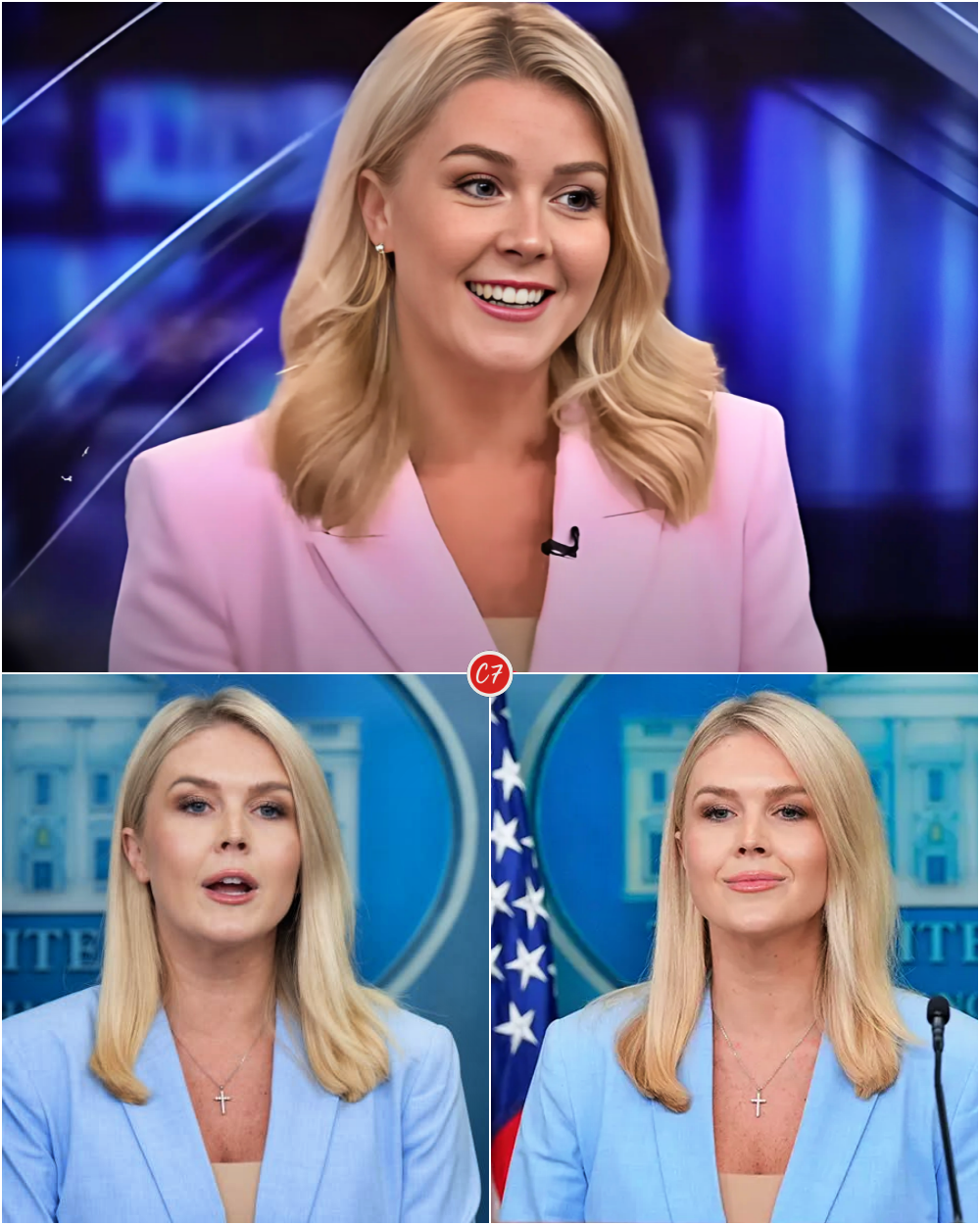
SHE DIDN’T FLINCH—AND THE SYSTEM BROKE ITSELF
They thought Karoline Leavitt would explode.
They expected her to cry, rage, lash out—or gloat.
But when she walked out of the courtroom with a quiet breath and a silver cross still gleaming on her collarbone, the world realized something far more terrifying than fury had just taken place.
She didn’t react like a politician.
She reacted like a reminder.
And that’s what no one was prepared for.
THE ROOM THEY COULDN’T CONTROL
That courtroom wasn’t made for protest. It was made for procedure. Cold benches. Worn carpet. A digital clock that blinked louder than any voice.
She wasn’t meant to speak. She wasn’t scheduled to testify.
But her presence disrupted everything.
She stepped in wearing a tailored gray suit and a pale pink blouse. The necklace hung just beneath the collar—small, silver, familiar. A cross.
No words had been said yet.
But the room noticed.
So did the judge.
He paused mid-sentence. Then lifted his eyes.
“Ms. Leavitt,” he said, tone even. “This courtroom requires neutrality.”
She didn’t blink. “So does justice.”
He leaned forward.
“Remove that symbol. Or remove yourself.”
She didn’t move.
So he fined her.
$500.
But it wasn’t the number that changed everything. It was the word he added as he marked the record:
“Fanatic.”
WHAT NO ONE SAID OUT LOUD
No one gasped.
That’s not how this kind of courtroom works.
The stenographer didn’t hesitate. The bailiff didn’t shift.
But something subtle fractured. Like a pressure crack in a glass wall. You can’t hear it, but you know it’s spreading.
Karoline didn’t respond.
Not then.
She simply placed her hand over the cross and breathed once—through her nose, not her mouth. Controlled. Intentional. Like she’d practiced this exact moment a thousand times.
She didn’t say anything.
But the room had already heard her.
THE CROSS THAT WASN’T JUST A SYMBOL
She’d worn it since she was sixteen.
Her mother had given it to her on a birthday no one remembered—except them. A quiet kitchen. A chipped mug. A prayer said halfway through tears.
“You don’t wear it for the world,” her mother had whispered. “You wear it so the world doesn’t wear you down.”
And until that day in court, it had never felt heavy.
But suddenly, that chain around her neck carried more weight than the building around her.
Not because of the metal.
But because of what it made visible.
A REACTION THAT DIDN’T FIT THEIR NARRATIVE
Most people expected a meltdown.
But Karoline didn’t tweet.
She didn’t post a single video.
What she did was more dangerous.
She called three people. None of them journalists. All of them had worn something of faith into a courtroom—and all of them had been warned, fined, or marked because of it.
She told them: “If you speak, I’ll follow. If you want silence, I’ll carry it for you.”
They didn’t answer right away.
But two weeks later, a woman knocked on her office door.
She said nothing. Just handed over a folder.
Inside: six years of notes, complaints, and transcripts. All involving quiet punishments for visible faith.
Handwritten in the margins of one:
“Necklace again. Cross. Advise her: we don’t tolerate instability in this space.”
The word circled: instability.
That was when Karoline stopped being quiet.
THE LAWSUIT THAT WASN’T ABOUT MONEY—BUT NEVER NEEDED TO BE
They say she sued for $800 million.
No one knows if that’s true.
She never confirmed it.
Never denied it either.
What she said—once, and only once—was this:
“If a number is what it takes to make them look, then fine. Let them look.”
From that point on, the lawsuit took on a life of its own.
It wasn’t about a fine.
It wasn’t even about a judge.
It was about a question no one in power had dared to answer:
What part of yourself are you still allowed to bring with you—when walking into a room where rights are supposedly equal?
THE FREEZE THAT CHANGED EVERYTHING
Midway through the pre-trial review, the defense called her cross “an accessory.”
Said it was no different than a pin or lapel badge.
Karoline didn’t argue.
She walked to the witness table, unclasped the chain, and set it down in the center of the desk—deliberate, gentle, but precise.
No sound.
But the silence that followed was electric.
Even the stenographer hesitated.
The air-conditioning clicked off.
And for the first time in the entire process—the judge looked uncertain.
Not because of what she’d said.
Because of what she didn’t have to.
THE BACKSEAT INTERVIEW
The night before closing arguments, Karoline gave her only media statement.
It wasn’t on camera.
A single reporter, invited into the backseat of her black SUV, was told:
“No cameras. No quotes unless I approve them.”
The conversation lasted four minutes.
Three lines made it to print:
“I didn’t come to challenge his authority.
I came because someone has to remember what happened when no one else would.
And sometimes remembering is more disruptive than shouting.”
That headline ran on page seven.
But by noon, it had gone viral.
THE LITTLE GIRL WHO WORE HERS ANYWAY
On the morning of the verdict, someone left a folded piece of paper outside her hotel door.
It wasn’t a legal memo.
It was a drawing.
Crayons.
A stick figure girl with a red dress and a cross necklace.
Underneath, in shaky handwriting:
“I wore mine today. Like you.”
Karoline held the note through the entire walk into the courthouse.
She didn’t show it to anyone.
But as she sat down, she folded it once more—and placed it gently into the inside pocket of her blazer.
Then she touched her necklace.
And smiled.
Not because she knew she would win.
But because, for the first time in weeks, she didn’t feel alone.
THE VERDICT, THE VANISHING JUDGE, AND THE WOMAN WHO DIDN’T WALK AWAY
The verdict wasn’t loud.
It didn’t come with applause or outrage. No gavel drop. No cheers. No slamming doors.
Just a printed sentence. Folded once. Slid across the bench.
“We find in favor of the plaintiff.”
Twelve words followed it—each more technical than emotional. Legal terms. Procedural corrections. Recommendations for policy review.
But one phrase, bolded and centered, was the only one anyone remembered:
“Systemic suppression of religious expression through visual discrimination.”
There were no cameras in the room.
But everyone there swore they saw it happen:
The judge blinked.
The first real emotion since the case began.
And Karoline?
She didn’t blink at all.
THE ROOM NO LONGER BELONGED TO HIM
The judge stood.
It was routine—verdicts end with a formal acknowledgment.
But this time, he didn’t speak.
He paused.
Like he wanted to say something but didn’t know what to say.
Like maybe, for a second, he understood what had just happened—and what it would mean.
Instead, he simply nodded to the clerk.
And walked out.
He never returned to that courtroom again.
THE PLAQUE AND THE EMPTY CHAIR
Three weeks later, an internal memo leaked:
The Hon. C.H. *** had officially “retired from public judicial service.”
No farewell statement. No comment to the press.
Just a bronze plaque on a door.
And an office left untouched.
Inside it, a single cardboard box with handwritten case notes, mostly irrelevant—except one page, underlined in red:
“Cross again. Claims not political. Still refuses to comply.”
Someone had drawn a question mark in the corner.
No signature.
No explanation.
It didn’t matter anymore.
Because the chair was empty.
WHAT HAPPENED OUTSIDE WASN’T STAGED—BUT THE WORLD WATCHED ANYWAY
Karoline walked out of the courthouse alone.
No entourage. No press team. Just a quiet pair of black heels against gray stone steps.
She stood there.
Not speaking. Not waving.
Just standing.
And then—without prompting—people began to gather.
First a handful. Then more. Some with signs. Some with nothing but silence.
And for once, the media didn’t ask questions.
They just filmed.
Because they realized something rare had happened.
A woman had walked into a place of power, said almost nothing—and somehow changed its shape.
THE MYTH THAT WOULDN’T DIE: $800 MILLION
Headlines couldn’t stop repeating it.
“Karoline Leavitt Awarded $800 Million in Courtroom Suppression Case”
“The Largest Faith-Based Verdict in U.S. History?”
“Win or Spin? What Does $800M Really Mean?”
The actual number?
No one official ever said.
Karoline never confirmed. Never denied.
Her only comment:
“It’s not about what I won.
It’s about what we don’t have to lose anymore.”
Still, the figure stuck.
It became legend.
Talk shows debated it. Columnists mocked it. TikTok turned it into audio.
But behind the noise, something quieter was happening:
Policy changed.
THE REAL REACTION: WHAT SHE DID NEXT
Most expected her to launch a political movement.
Or at least a speaking tour.
Instead, she did one thing:
She returned—silently—to the courthouse steps.
But this time, she sat.
Just like before. No signs. No fanfare.
Except this time, she wore a different cross.
Same silver. Same chain.
But it wasn’t hers.
It belonged to a woman from Kansas—fined in 1996 for refusing to remove it during jury duty.
Her granddaughter had mailed it to Karoline with a note:
“She died thinking no one would ever understand what that moment cost her.
Now she doesn’t have to be alone.”
Karoline wore it for an entire week.
No posts. No explanation.
Just visibility.
THE CLERK WHO NEVER SPOKE—UNTIL SHE DID
Six months after the verdict, a court clerk anonymously submitted a 9-page affidavit.
In it, she detailed nearly 40 quiet incidents of “faith-related adjustments” across multiple judgeships.
But one section was different.
She wrote:
“The only time I ever questioned what we were doing was when Ms. Leavitt walked in and didn’t look at anyone.
Not with challenge. Not with fear.
Just… as if she already knew how it would end.
And she wasn’t waiting for permission.”
THE RIPPLE THEY DIDN’T PREDICT
In New Mexico, a teenage girl wore a rosary to her immigration hearing.
No one stopped her.
In Chicago, a Sikh man was told “your turban is fine here” without being asked to remove it.
In Maine, a courtroom posted a sign:
“Faith symbols are not forbidden unless used to disrupt.”
And in a quiet courthouse in Georgia, an elderly woman sat in the gallery with a cross pin on her coat.
When asked if she was here for someone, she said,
“No. I’m just sitting.
Because for the first time in a long time…
I feel allowed to.”
WHAT KAROLINE NEVER SAID—AND WHY IT MATTERED MORE
She never published a memoir.
Never claimed martyrdom.
Never campaigned on the victory.
Instead, she gave a single talk—at a small school in Virginia.
No press. No recording.
But someone who was there remembered a line and wrote it on a napkin:
“They didn’t take away my cross.
They tried to take away my stillness.
And that was the part I refused to let them have.”
THE WOMAN ON THE STEPS—AGAIN
Months passed.
One day, a reporter walked past the D.C. courthouse and saw her again.
Same bench. Same coat. Same presence.
But this time, someone else sat beside her.
A young woman—maybe twenty. Nervous. Glancing around.
Then Karoline turned to her, smiled once, and said:
“You don’t have to speak yet.
You’re already here.
That’s louder than anything.”
The moment was short.
But a photographer, across the street, caught the shot.
No headline could match it.
But the caption that ran with it read:
“She didn’t win the system.
She changed the air inside it.”
FINAL REFLECTION
Not every reaction needs a microphone.
Some of the most radical answers to injustice happen in silence.
A hand on a necklace.
A woman refusing to move.
A girl drawing hope in crayon.
Karoline didn’t just react to the verdict.
She redefined what reacting looks like.
Not as noise.
But as presence.
And for every person who ever sat still—wondering if their stillness meant weakness—
She gave a new answer.
Disclaimer:
This story is an interpretive narrative inspired by real-world dynamics, public discourse, and widely resonant themes. It blends factual patterns with creative reconstruction, stylized dialogue, and reflective symbolism to explore deeper questions around truth, loyalty, and perception in a rapidly shifting media and cultural landscape.
While certain moments, characters, or sequences have been adapted for narrative clarity and emotional cohesion, they are not intended to present definitive factual reporting. Readers are encouraged to engage thoughtfully, question actively, and seek broader context where needed.
No disrespect, defamation, or misrepresentation is intended toward any individual, institution, or audience. The intent is to invite meaningful reflection—on how stories are shaped, how voices are heard, and how legacies are remembered in the tension between what’s said… and what’s meant.
Ultimately, this piece honors the enduring human search for clarity amidst noise—and the quiet truths that often speak loudest.






